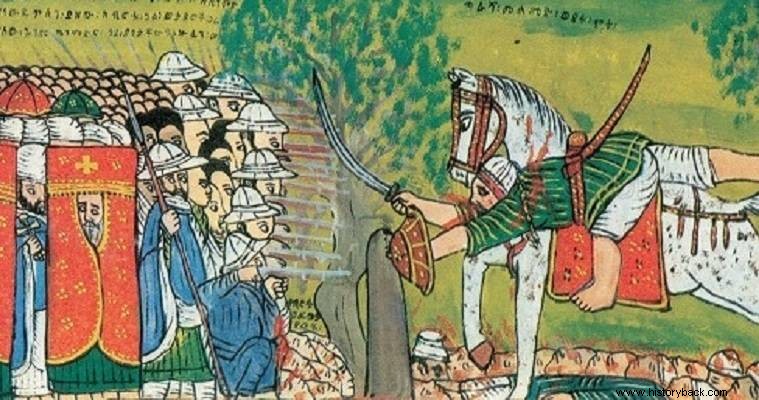
Ethiopia, known for centuries as Abyssinia, is one of the oldest states in Africa. With a strong Christian element, in the 16th century it found itself fighting for survival against the Muslims of Ahmad Gran (Ahmed the Left-Handed), who were supported by Sultan Suleiman the so-called "The Magnificent".
The Sultanate of Adal was the most powerful Muslim state in the Horn of Africa, and its essential leader, the fanatical Imam Ahmad, with an army of Somalis, Hararites, Arabs, and Turks, equipped with firearms, overcame the Ethiopians of Emperor David II.
The army
The bitter war began in 1529 and ended in 1543 with the victory of the Ethiopians under Emperor Claudius and their Portuguese allies and the death of Ahmad. Before the arrival of the Portuguese the Ethiopian army was absolutely primitive. He had sufficient but unruly light cavalry and unruly warriors armed with javelins, swords and leather shields.
There were also many warriors armed with bows. These forces were formed on a tribal basis by the local chiefs who owed a feudal obligation to the respective emperor. There were no organized units and even the "imperial" troops were organized accordingly since the emperor was really nothing but the strongest leader. Most likely the divisions were organized by tens, hundreds and thousands.
Due to the superiority of the Muslims in weight and quality of cavalry, the archers covered the flanks of the infantry who were in the center of the formation. The Ethiopian light horsemen, armed with javelins and small shields, could not withstand the charge of the spear-armed, armour-bearing, fanatical Muslim horsemen.
The infantry lined up in loose formations so that the men could throw their javelins before engaging the opposing infantry. Sometimes javelins were not thrown but were used as spears. The foot warriors were armed with the famous Ethiopian sword, the sotel, which resembled a machete or scythe.
Sometimes groups of warriors were arranged in an acrobolism formation and fought like the ancient Psiloi. And divisions of archers could be deployed in a strafing arrangement. Archers in addition to the bow usually had a hand or short sword.
In hand-to-hand combat, the conflict with opposing infantry developed into a particularly bloody confused struggle where skill in the use of weapons, physical prowess and fanaticism were the elements that gave victory. However, the Ethiopian infantry were in particular danger from the attack of the Muslim heavy cavalry as they did not have weapons capable of intercepting it.
Infantrymen had no military training beyond the empirical, acquired on the battlefield over the years. Most were followers of various local chiefs, or farmers and herders. Firearms were made available to the Ethiopians by the Portuguese, arquebuses first and muskets later, in limited quantities.
The Catalytic Battle
An important reinforcement was a body of about 400 Portuguese who helped the Ethiopians in the fight against Ahmad. After all, the latter was killed by a fireball from a Portuguese arquebusier, in 1543 in the battle of Waina Daga.
In this battle the emperor Claudius fielded 8,000 Ethiopian infantry and 500 cavalry, 60 Portuguese cavalry and 70 Portuguese arquebusiers. Ahmad had 12,000 infantry, 1,200 cavalry and 200 Turkish arquebusiers.
Emperor Claudius' army, reinforced with Portuguese arquebusiers, moved in search of Ahmad's army. When the Ethiopians spotted him they camped nearby. Several days passed with the two rivals limiting themselves to small raids. Claudius hesitated to attack as he awaited the arrival of 50 Portuguese arquebusiers. In the meantime, in the continuous skirmishes, the Ethiopians gradually prevailed, confining their opponents to their camp.
However, in a skirmish Ahmad himself killed a prominent Ethiopian, Azmeh Keflo, which demoralized Claudius' men. The emperor, however, precisely to raise the morale of his army decided to attack. The Ethiopians lined up conventionally as their opponents also excelled in cavalry. Ahmad ordered his forces into two corps, one composed of his Turkish allies. The Muslims attacked with vigor and drove back their opponents.
But a counterattack by the Ethiopian horsemen, who were supported by their fire by the Portuguese arquebusiers, overthrew the Muslims. Ahmad along with his son attempted to regroup their forces and fight back. But an arquebus shot hit them and knocked him dead from his horse.
According to the eyewitness Portuguese Castanozo, the spearmen recognized Ahmad and fired a volley at him. One of the fireballs hit him and killed him. According to the sources it was Joao Bermudas who killed Ahmad.
Later regular corps of arquebusiers and musketeers were formed trained by the Portuguese who remained in the country after the end of the war. Despite his weaknesses and initial defeats the Ethiopian fighters managed to prevail in the long war against their fanatical opponents.
